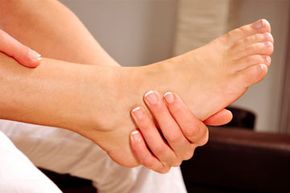Smelly feet start with sweaty feet, which can be a problem with embarrassing consequences. It may not be the worst affliction in the world, but if your socks are constantly damp and sweaty, you may have hyperhidrosis. Hyperhidrosis is the medical term for excessive sweating [source: Mayo Clinic]. Botox is one way to treat it.
Botox, short for botulinum toxin, works by paralyzing certain muscles, which is why it gives your face a smoother appearance when it's injected to reduce the appearance of wrinkles. To treat hyperhidrosis, Botox blocks the nerves that tell your sweat gland to produce a lot of sweat. The U.S. Food and Drug Administration (FDA) approved Botox for severe underarm sweating in 2004, but dermatologists use it successfully for feet and other areas affected by hyperhidrosis as well, such as hands, head and face [source: MSNBC].
Advertisement
Even though hands and feet each have about a quarter of a million sweat glands, smelly feet are more common than sweaty hands, because bacteria that thrive in your socks cause an unpleasant odor. Remember, sweat itself doesn't actually smell. When sweat makes your shoes and socks warm and damp, bacteria trapped inside start to feed on it. They then excrete an organic acid that gives off that telltale smell [source: Clausen].
Botox shots can be painful, though, and it may take more than one treatment before you experience any results. Even if you do come out smelling better, you will have to repeat the process about every four months, since the effects are temporary. The good news is that the risk of side effects is minimal [source: Mayo Clinic].
Your first step in treating those smelly feet is an appointment with a dermatologist. He or she can diagnose hyperhidrosis and make sure the sweating and the odor are not symptoms of another condition. Then you can discuss the available options, including Botox.
To learn more about excessive sweating and what you can do about it, see the links on the following page.
Advertisement


